If you’re thinking of opening a coffee shop, you must also be wondering what you need aside from the building itself. There’s a lot that goes into opening a coffee shop, from the equipment down to the paint on the walls. The most popular and beloved cafes in the world all have that special something that’s really hard to pin down, but nevertheless makes them truly unique.
That special something isn’t any one thing – it’s a combination of factors that together are what will bring customers coming back. It’s the flavor of the coffee, it’s the service the customers receive, and it’s the environment that they feel welcomed by.
9 Things You Should Consider Before Opening a Coffee
This checklist will make all the difference.
1. Espresso Machine
An espresso machine is the front line of a coffee shop. It’s true that some people do come to coffee shops for a regular black drip coffee, but cappuccinos and lattes are still the stars. Espresso drinks—of any variety! The more the merrier! – can make or break a coffee shop. Intricate latte art is becoming more popular—especially
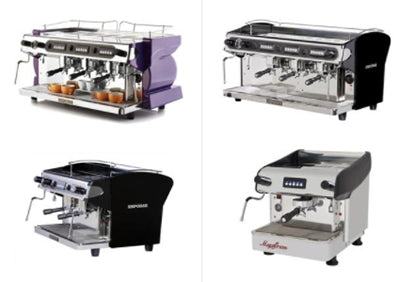
You can never skimp on an espresso machine, and even buying used is asking for trouble. What would you do if your espresso machine broke down in the middle of a busy morning? Depending on the size of your coffee shop, it’s a good idea to have one machine with two group heads, although three or four might be overkill, because there’s not generally enough space for people to man that many group heads on one countertop. If you expect a really high volume, it might be a good idea to have a second espresso machine with just one group head, but one should be enough.
Think of this as the heart of your business, and do your homework! And don’t think an espresso machine is the only key to good espresso coffee...
2. Espresso Grinder
Espresso grinders are the underrated heroes of every espresso drink. There are plenty of coffee connoisseurs and aficionados that swear that an espresso grinder is even more important than an espresso machine is. You can spend thousands of dollars on an espresso machine, but you won’t get very far without a quality grinder able to grind coffee beans to the miniscule size that’s necessary to brew an espresso.
In general, it’s a good idea to invest as much in your grinder as you do in the espresso machine itself. It does at least half of the work that the espresso machine does, though it gets none of the credit. The brewing method of espresso is harsh, using more than 135 pounds of water pressure per square inch to extract an espresso coffee in about half a minute. It’s harsh on the ground coffee bean, and this process is made easier and gentler with a great grinder to prep your espresso beans into a fine ground that can handle the pressure and produce a delightful, delicately flavored, strong espresso.
3. Water Filter
If an espresso machine is the cornerstone of a coffee shop, a water filter is the front line. No matter how fancy your equipment is, no matter how flavorful your coffee beans or roast, you’ll never make good coffee using bad water. A high-quality and reliable water filter is the front line of your coffee shop, setting you up for success before you even start brewing. Brewing coffee with filtered water is the only way to
Without a water filter, every one of your beverages will be affected by any impurities in the tap water. Acidic or basic water, or hard water full of minerals can dramatically change the flavor of your coffee beans. Not only that—water with minerals will wear your espresso and drip machines down well before their time.
The machines will collect a buildup of mineral residue that will break your machine if you don’t clean it regularly at least every year. And cleaning and servicing can get expensive! Maintaining and replacing a coffee machine due to the damage caused by hard water will quickly become more expensive than the original cost of buying a water filter, so don’t cheat yourself!
4. Drip Coffee Machine
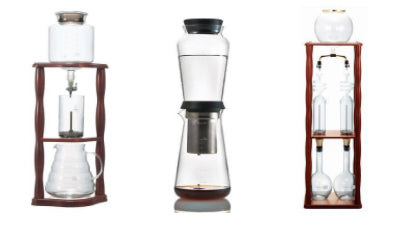
While it’s true that your cafe needs top-notch cappuccinos and lattes and espresso-based drinks, there will be plenty of people just looking for a regular (or decaf) cup of drip coffee. And they will want something that tastes a whole lot better than mud from the corner store!
Of course, it won’t be enough to get the kind with the small reservoir in the back that has to be refilled. You’ll be filling and refilling the machine all day long, and you’ll have to constantly tell people to wait for a new brew. Instead, get a drip coffee machine that’s hooked up to your main water line. Keep the pot hot and full.
There are a few factors that separate good drip coffee machines from cheap ones, and you’ll taste the difference. Water temperature is a huge one. Water that’s too hot will burn your coffee, just like an oven that’s too hot will burn whatever you’re cooking. Nothing’s worse than burned coffee—you can taste it even through the milk and sugar.
But it’s so common! And have you ever tried making coffee with cold water? You end up with something more like coffee-flavored water and miss out on all the rich flavors, not to mention the caffeine, which is definitely not the way anyone wants to kickstart their day. At the right temperature, a good drip coffee machine will extract the perfect balance of sweetness, acidity, and just a touch of bitterness. So get a drip coffee machine that lets you set the temperature. It makes all the difference—or at least half of it.
The rest of the difference lies in water distribution. There are too many drip coffee machines that just dump all the water down in one place, and maybe the rest of the grounds get wet by accident or just by soaking up the nearby water. A good drip coffee machine really makes sure all the coffee grounds get wet and saturated, allowing you to extract the flavor from every little coffee ground. The best coffee makers on the market even pre-infuse the grounds, wetting everything a little bit a few minutes before the true pour, so you can make sure everything’s saturated and extracting every bit of flavor you possibly can.
5. Bulk Coffee Grinder
If your coffee beans are good enough to keep people coming back, why don’t you try selling the beans themselves? That perfect roast can be your signature, and if people love the flavor they’ll want to drink it at home, and they’ll want to gift it to friends and families for all kinds of occasions. But coffee keeps its flavor best in whole beans, so it’s a good idea not to grind the whole bag until you’re ready to use it. And most people don’t have coffee grinders at their homes. So if you sell coffee beans, make sure you have a grinder ready for people to bring their delicious beans in to grind and take back home—and it should be big enough to grind up a whole pound.
6. Blender
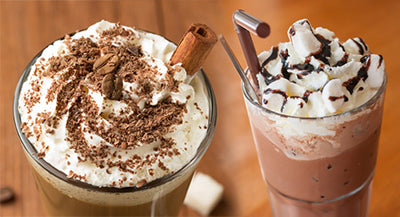
The frappe (or at Starbucks, the “frappuccino”) is the coffee drink for people with a sweet tooth, or the perfectly refresher for a midday kick. Blended coffee beverages with a variety of flavors have become protocol at lots of shops, and they’re perfect for adults and kids alike (maybe without the coffee for the kids…). And there’s more use for a blender than just frappes!
You might be opening a coffee shop, but have you considered serving anything other than coffee and tea? Smoothies are becoming a normal part of the menu at cafes all over the world. People want the conversation, comfort, convenience, and routine of coffee shops, but increasingly people are working towards getting healthier and cutting out caffeine from their diets.
So instead of going out of business, cafes everywhere have started tossing an array of smoothies on their menus, from simple strawberry-banana smoothies to tropical and exotic blends. Having a blender means you can play with flavors and even offer customers a choice of fruits from a longer menu.
7. Refrigerator And Pastry Case
Of course, you’ll need a refrigerator to keep milk and cream in, but what about pastries and snacks? There are few small pleasures in this world more delightful than settling in with a hot cup of coffee and breakfast or a snack. This can be something warmed up like a pastry, or something cool like a yogurt or fruit or a tuna sandwich. This means you’ll want a glass pastry case with multiple temperature options—room temperature and cool—as well as a refrigerator for your own supplies, and a freezer for ice.
Now that you’re offering people espresso beverages, drip coffee, blended frappes and smoothies, as well as food, there’s no reason to go anywhere else! There’s only a few other things you need to consider before you’ve got the coolest coffee shop on the block.
8. Furniture And Mugs
Now that your espresso, drip coffee, and blended beverages are in order, customers are going to want to sit down to enjoy their amazing beverages—and maybe give themselves time to order more! You’ll want to give people who intend to sit down and enjoy a slow cuppa a good, solid mug to sip from. There’s nothing quite like the feeling of a hot, heavy mug in your hands. It feels like home, like work and relaxation all together.
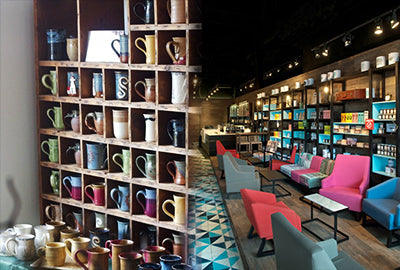
A cardboard cup just doesn’t do the same job. So make sure you invest in coffee mugs that match your décor or the vibe you’re shooting for. They don’t even have to match each other, if eclectic is your style. And if high end is your style, consider adding saucers for under the mugs. Handing a customer a coffee mug on a saucer with a spoon and cookie is a really nice, classy touch.
And don’t forget the furniture! It’s nice to sip coffee from a mug, but it’s even nicer to do it from a comfortable chair or even a couch. Consider what your customers will want, and how your cafe is designed. If your customers will want to stare out the giant glass windows out front, maybe you should add barstools to a long countertop. If they’ll want to lounge for a while and meet friends, maybe some couches are the way to go. Will they want to do work and have meetings? Long tables to spread out paperwork and comfortable chairs that you can sit in for a few hours at a time are the way to go!
9. WiFi
These days, fast and reliable internet access is just as important to customers as good coffee. Free wifi has become so ubiquitous at cafes and restaurants that the phrase has become redundant. But free isn’t enough—it should be fast, reliable, and more than appropriate for the number of people you expect to be using it. Bloggers and cafe reviewers frequently rate coffee shops on the upload and download speed of their wifi.
Reviewers often knock off major points if they have trouble doing simple tasks like checking email or Facebook Messenger. And now that embedded videos have become so popular on social media sites like Facebook and Instagram, people of all ages expect to be able to access web content of all kinds, even high bitrate videos, at the tips of their fingers.
Cafes have always been places for meeting and communication, and things haven’t changed with the dawn of technology. Instead, people are now able to use cafes as a place to catch up with friends and hold meetings that aren’t even in the room. It’s becoming common to see more than one person tucked into quiet corners of a coffee shop to hold business meetings, consult with clients, or keep in touch with people living on the other side of the world. That means you need to make sure your wifi router is good enough to support everyone’s needs—from simple Google searches to YouTube and Skype.
Barista Warehouse believes that making sure your customers have access to great wifi is also a great way way to make sure that they use their social media accounts to let everyone know how great your cafe is: from the cozy chairs down to the kickin’ cappuccinos.
source
https://baristawarehouse.com.au/blogs/learn/coffee-shop-checklist
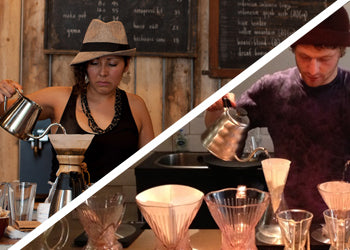 ● It’s inexpensive.
● It’s inexpensive.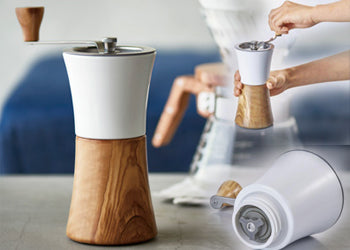 Hario doesn’t just make excellent electric coffee grinders; they also make excellent manual grinders. For $169.95 you get a small, hand-powered grinder that can make french press, espresso, and every grind in between.
Hario doesn’t just make excellent electric coffee grinders; they also make excellent manual grinders. For $169.95 you get a small, hand-powered grinder that can make french press, espresso, and every grind in between.
 ● It’s inexpensive.
● It’s inexpensive.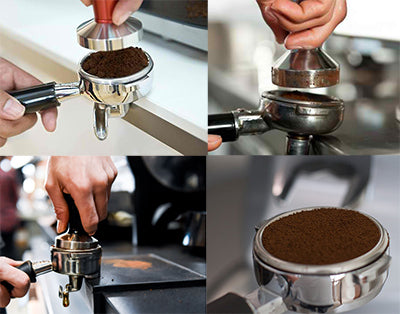 Tamping is simply the method that baristas use on loosely packed coffee grounds in the portafilter to turn them into a tightly compressed and evenly dispersed puck. It is meant to create the necessary resistance to the pressurised water to extract the espresso flavour from the grounds. Water is lazy and if allowed will choose the weak path through the grounds and thus failing to extract the required flavour. Actually, tamping is the second in the process of making coffee after bean grinding. That’s why it’s important to have it done correctly. Without proper tamping of the ground, the rest of the steps to making espresso will not make any difference.
Tamping is simply the method that baristas use on loosely packed coffee grounds in the portafilter to turn them into a tightly compressed and evenly dispersed puck. It is meant to create the necessary resistance to the pressurised water to extract the espresso flavour from the grounds. Water is lazy and if allowed will choose the weak path through the grounds and thus failing to extract the required flavour. Actually, tamping is the second in the process of making coffee after bean grinding. That’s why it’s important to have it done correctly. Without proper tamping of the ground, the rest of the steps to making espresso will not make any difference.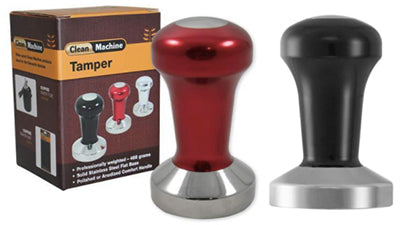 Dual-Head Tamper - this one is the most popular with baristas using multiple filter baskets. It actually looks like a lopsided dumbbell. It comes with two flat ends where one is small than the other. This enables the barista to use one tamper on two different baskets.
Dual-Head Tamper - this one is the most popular with baristas using multiple filter baskets. It actually looks like a lopsided dumbbell. It comes with two flat ends where one is small than the other. This enables the barista to use one tamper on two different baskets. You can never skimp on an espresso machine, and even buying used is asking for trouble. What would you do if your espresso machine broke down in the middle of a busy morning? Depending on the size of your coffee shop, it’s a good idea to have one machine with two group heads, although three or four might be overkill, because there’s not generally enough space for people to man that many group heads on one countertop. If you expect a really high volume, it might be a good idea to have a second espresso machine with just one group head, but one should be enough.
You can never skimp on an espresso machine, and even buying used is asking for trouble. What would you do if your espresso machine broke down in the middle of a busy morning? Depending on the size of your coffee shop, it’s a good idea to have one machine with two group heads, although three or four might be overkill, because there’s not generally enough space for people to man that many group heads on one countertop. If you expect a really high volume, it might be a good idea to have a second espresso machine with just one group head, but one should be enough. While it’s true that your cafe needs top-notch cappuccinos and lattes and espresso-based drinks, there will be plenty of people just looking for a regular (or decaf) cup of drip coffee. And they will want something that tastes a whole lot better than mud from the corner store!
While it’s true that your cafe needs top-notch cappuccinos and lattes and espresso-based drinks, there will be plenty of people just looking for a regular (or decaf) cup of drip coffee. And they will want something that tastes a whole lot better than mud from the corner store! The frappe (or at Starbucks, the “frappuccino”) is the coffee drink for people with a sweet tooth, or the perfectly refresher for a midday kick. Blended coffee beverages with a variety of flavors have become protocol at lots of shops, and they’re perfect for adults and kids alike (maybe without the coffee for the kids…). And there’s more use for a blender than just frappes!
The frappe (or at Starbucks, the “frappuccino”) is the coffee drink for people with a sweet tooth, or the perfectly refresher for a midday kick. Blended coffee beverages with a variety of flavors have become protocol at lots of shops, and they’re perfect for adults and kids alike (maybe without the coffee for the kids…). And there’s more use for a blender than just frappes! A cardboard cup just doesn’t do the same job. So make sure you invest in coffee mugs that match your décor or the vibe you’re shooting for. They don’t even have to match each other, if eclectic is your style. And if high end is your style, consider adding saucers for under the mugs. Handing a customer a coffee mug on a saucer with a spoon and cookie is a really nice, classy touch.
A cardboard cup just doesn’t do the same job. So make sure you invest in coffee mugs that match your décor or the vibe you’re shooting for. They don’t even have to match each other, if eclectic is your style. And if high end is your style, consider adding saucers for under the mugs. Handing a customer a coffee mug on a saucer with a spoon and cookie is a really nice, classy touch.